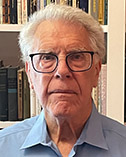
Elliot L. Elson
Washington University in St. Louis
|
Primary Section: 29, Biophysics and Computational Biology Membership Type:
Member
(elected 2021)
|
Biosketch
Elliot Elson along with others developed methods, Fluorescence Correlation Spectroscopy and Fluorescence Recovery After Photobleaching, that are especially useful for measuring molecular transport (diffusion and convection) and chemical reaction kinetics in very small systems. He investigated how proteins and smaller molecules diffused on and in single cells and has also studied cellular biomechanics of cardiomyocytes and fibroblasts in reconstituted tissue constructs. Elson was born and grew up in St. Louis, Missouri. He received his undergraduate education at Harvard College, his PhD in Biochemistry at Stanford University mentored by Robert L. Baldwin and did postdoctoral work in the laboratory of Bruno H. Zimm at the University of California, San Diego. He was a faculty member in the Department of Chemistry of Cornell University and then in the Department of Biochemistry and Molecular Biophysics at Washington University School of Medical in St. Louis. He is a Fellow of the Biophysical Society from which he received the Ignacio Tinoco Award.
Research Interests
Elliot Elson’s laboratory has studied motions and interactions of molecules on and in single cells using fluorescence correlation spectroscopy and photobleaching. Current work seeks to do similar measurements using optical properties other than fluorescence. More recently he and coworkers have focused on biomechanical properties and functions of cells, mainly in reconstituted tissue constructs. Engineered heart tissue constructs that include cardiomyocytes and other cell types provide models of natural heart tissue that can be used to test potential pharmaceuticals. Fibroblasts are connective tissue cells present in all solid tissues. These cells produce the Extracellular Matrix (ECM) in which tissue cells are embedded and, under normal conditions, maintain mechanical homeostasis essential for cell function. In response to injury or pathology fibroblasts undergo an epigenetic transformation to a cell type, the myofibroblast, that has properties of both fibroblasts and smooth muscle cells. Production of ECM components and exertion of cellular contractile forces contribute to closing and healing wounds but also can produce tissue stiffening and fibrotic disease in organs such as heart, lung, and liver. Of particular interest are the mechanism of the fibroblast to myofibroblast transformation and the bidirectional feedback mechanisms that cause myofibroblasts to polarize and exert forces that compress and stiffen tissues both in normal wound healing and in pathological fibrosis.

